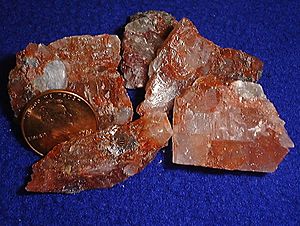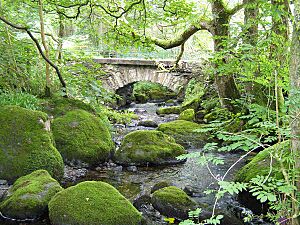Potash pit facts for kids
Potash pits were special places where people made something called potash a long time ago, before big factories existed. These pits were like small ovens dug into the ground and lined with stones. Potash was super important for making a soft soap. This soap was used to clean wool, especially to remove the natural oils (called lanolin) from it. Cleaning the wool was a key step before it could be spun into yarn for clothes.
Contents
Making Potash for Cleaning Wool
Potash pits were simple, stone-lined areas where people made a special cleaning solution. First, they would burn hard woods like birch or plants like bracken to create ashes. These ashes were then put into a large copper pot.
Water and a substance called quicklime were added to the ashes in the pot. This mixture was then boiled. The ashes and quicklime created a strong, soapy liquid. This liquid is known as an alkaline solution.
Once the solution was strong enough, it was filtered to remove any bits of ash. Then, fats were added to this clean, alkaline liquid. This mix created a soft soap. This soap was essential for cleaning and degreasing wool. Removing the natural oils from wool was a very important step before it could be spun into yarn.
Where Were Potash Pits Built?
Potash pits were usually built in or very close to areas with lots of the right kind of trees. These were often deciduous woodlands, meaning trees that lose their leaves in autumn. Finding these pits today tells us a lot about the past. They show us where wool was processed and where suitable woodlands existed long ago.
How Potash Pits Were Constructed
These pits were often circular in shape. They were usually built into natural earth banks. The inside walls of the pits were carefully lined with drystone walling. This means stones were stacked without using any mortar.
A special tunnel-like fireplace was also part of the pit. This fireplace helped to pull air in. This air was needed to burn the wood or bracken. The burning created the ashes, which were then used to make the potash. The fireplace also helped to heat the large cauldron where the potash solution was made.
Examples of Potash Pit Locations
Potash pits are often found in places where sheep farming was common and where there were large woodlands. A good example is the Lake District in England. One specific potash pit can be found in the Lickle Valley, near a place called Broughton in Furness.
Potash Pits in History
When we look at old landscapes, the remains of potash pits can sometimes look a bit like other historical sites. For example, they might seem similar to Q-pits. Q-pits were used to make "white coal," which was a special fuel for melting lead.
Another type of pit found in woodlands is a Saw pit. However, saw pits were rectangular. This shape makes them easy to tell apart from the rounder potash pits. Studying these old sites helps us understand how people lived and worked in the past.



